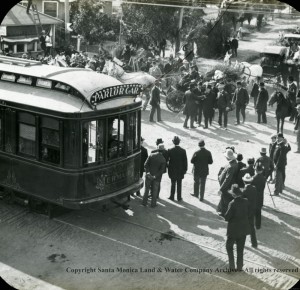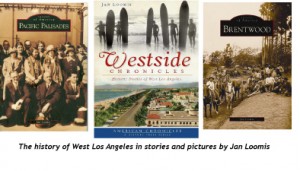
These days the mood in Los Angeles is anything but celebratory when the president of the United States arrives for a visit—snarled traffic and blocked off streets cause delays and aggravation instead of jubilation . It wasn’t always that way though. In May 1901, the entire city, population about 100,000, turned out to welcome newly re-elected President William McKinley. Contemporary accounts of his arrival on May 8th, 1901 tell of “shouts of welcome from thousands of people heard all over the downtown district.” The din included long strings of Chinese firecrackers exploding in the Chinese quarter, canons booming and steam whistles.
McKinley had been reelected for a second term and inaugurated in March. Almost immediately he planned a seven week tour through the Western states. It would be the first time a president would use the railroads for a national tour. Travelling by private rail car with his wife and entourage, he went first through the South to New Orleans. From there he traveled on the Southern Pacific tracks thru Texas with stops in College Station, Austin, and El Paso where he met with Mexican president Porfirio Diaz. His wife who accompanied him on the tour crossed over into Juarez for an event making her the first first lady to leave the United States while her husband was in office. The next stop was Los Angeles.
The Merchants and Manufacturers Association had invited the president to Los Angeles and timed his visit to coincide with the Fiesta de Las Flores—an event designed to promote Los Angeles for businesses and tourism to the rest of the country. One of the chief promoters of the visit (and the Merchants and Manufacturers Association) was Harrison Grey Otis, the president of the Los Angeles Times. Otis served with McKinley in the Civil War and fought in the Philippines during the Spanish American War. He was appointed a General by McKinley—a title he used for the rest of his life.
The pictures of the day show McKinley and his wife seated in a flower bedecked carriage drawn by white horses moving along the parade route on Broadway. Later in the day they reviewed the parade from the grandstand and then attended a reception at the Van Nuys Hotel. McKinley and his wife spent the night at General Otis’ home.
The next day the president boarded the Mermaid, General Moses Sherman’s private streetcar, to deliver a speech at the Pacific Branch, National Home for Disabled Volunteer Soldiers most of whom were fellow Civil War veterans. McKinley fought with distinction during the Civil War receiving a battlefield commission and rising to the rank of major—the title he preferred all his life. His interest in the veterans ran deep.
The photos show a large crowd gathered in front of the Soldier’s Home Dining Hall to hear the speech. Among those present were six year old Dorothy Gillis and her grandmother—Mary Clark Lindsey. “Dana” as she was known in the family was the widow of Stephen Decatur Lindsey, a congressman from Maine. She and her husband had known President McKinley in Washington hence her invitation to the event. Why she took her small granddaughter to meet the president is lost to time, but Dorothy remembered shaking the president’s hand and talked about it all her life.
This photo, printed from a glass negative, shows the Mermaid parked at the station in Sawtelle, the town that grew up around the Soldier’s Home. McKinley, at the center of the photo in his top hat, is apparently getting ready to board the Mermaid for the trip back to Los Angeles. One man climbed the ladder to give his daughter a better view and there is a photographer, also elevated above the crowd, behind the carriage.
